Herbicide in Weed Management of Wheat (Triticum aestivum L.) and Rainy Season Rice (Oryza sativa L.) under Conservation Agricultural System
Abstract
1. Introduction
2. Materials and Methods
2.1. Area of the Study
2.2. Climatic Condition during Cropping Seasons
2.3. Experimental Treatments and Design
2.4. Experimental Procedure
2.5. Data and Their Collection Procedures
2.6. Statistical Analysis
2.7. Economic Analysis
3. Results and Discussion
3.1. Effect of Herbicides on Weeds in Strip-Till Wheat
3.2. Impact of Herbicides on Yield Attributes and Yield of Wheat and Economic Analysis
3.3. Effect of Herbicides on Weeds in Rainy Season Rice
3.4. Effect of Herbicides on Yield Contributing Characters, Yield and Economics of Rainy Season Rice
4. Conclusions
Author Contributions
Funding
Institutional Review Board Statement
Informed Consent Statement
Data Availability Statement
Acknowledgments
Conflicts of Interest
References
- FAO (Food and Agriculture Organization of the United Nations). Save and Grow, a Policymaker’s Guide to Sustainable Intensification of Smallholder Crop Production; FAO: Rome, Italy, 2011; 116 p. [Google Scholar]
- Salahin, N.; Alam, K.; Mondol, A.T.A.M.I.; Islam, M.S.; Rashid, M.H.; Hoque, M.A. Effect of tillage and residue retention on soil properties and crop yields in wheat-mungbean-rice crop rotation under subtropical humid climate. Open J. Soil Sci. 2017, 7, 1–7. Available online: http://www.scirp.org/journal/ojss (accessed on 25 July 2021).
- Kushwaha, C.P.; Tripathi, S.K.; Singh, K.P. Soil organic matter and water-stable aggregates under different tillage and residue conditions in a tropical dry land agro-ecosystem. Appl. Soil Ecol. 2001, 16, 229–241. [Google Scholar] [CrossRef]
- Kumar, N.B.T.; Babalad, H.B. Influence of conservation agriculture practices on biological soil quality. Int. J. Curr. Microbiol. App. Sci. 2018, 7, 312–322. [Google Scholar] [CrossRef]
- Bell, R.W.; Haque, M.E. Conservation agriculture and mechanization for smallholder agriculture: A win-win for agriculture and the environment. In 2nd Conference on Conservation Agriculture for Smallholders (CASH-II); Bell, R.W., Vance, W., Haque, M.E., Jahiruddin, M., Hashem, A., Brennan, R., Rahman, M.M., Eds.; Bangladesh Agricultural University: Mymensingh, Bangladesh, 2017; pp. 6–7. [Google Scholar]
- Congreves, K.A.; Hayes, A.; Verhallen, L.L.; Van Eerd, L.L. Long term impact of tillage and crop rotation on soil health at four temperate agroecosystems. Soil Tillage Res. 2015, 152, 17–28. [Google Scholar] [CrossRef]
- Corsi, S.; Muminjanov, H. Conservation Agriculture: Training Guide for Extension Agents and Farmers in Eastern Europe and Central Asia; FAO: Rome, Italy, 2019; 123 p. [Google Scholar]
- Frąc, M.; Hannula, S.E.; Bełka, M.; Jędryczka, M. Fungal Biodiversity and Their Role in Soil Health. Front. Microbiol. 2018, 9, 707. [Google Scholar] [CrossRef]
- Hou, D.; Bolan, N.S.; Tsang, D.C.W.; Kirkham, M.B.; O’Connor, D. Sustainable soil use and management: A interdisciplinary and systematic approach. Sci. Total Environ. 2020, 10, 729. [Google Scholar] [CrossRef]
- Huera-Lucero, T.; Labrador-Moreno, J.; Blanco-Salas, J.; Ruiz-Téllez, T. A Framework to incorporate biological soil quality indicators into assessing the sustainability of territories in the Ecuadorian Amazon. Sustainability 2020, 12, 3007. [Google Scholar] [CrossRef]
- Lehman, R.M.; Cambardella, C.A.; Stott, D.E.; Acosta-Martinez, V.; Manter, D.K.; Buyer, J.S.; Maul, J.E.; Smith, J.L.; Collins, H.P.; Halvorson, J.J.; et al. Understanding and enhancing soil biological health: The solution for reversing soil degradation. Sustainability 2015, 7, 988–1027. [Google Scholar] [CrossRef]
- Rojas, R.V.; Moujahed, A.M.; Maroulis, J.; Caon, L. Healthy soils: A prerequisite for sustainable food security. Environ. Earth Sci. 2016, 75, 180. [Google Scholar] [CrossRef]
- Bell, R.W.; Haque, M.E.; Jahiruddin, M.; Rahman, M.M.; Begum, M.; Miah, M.A.M.; Islam, M.A.; Hossen, M.A.; Salahin, N.; Zahan, T.; et al. Conservation agriculture for rice-based intensive cropping by smallholders in the Eastern Gangetic Plain (EGP). Agriculture 2018, 9, 5. [Google Scholar] [CrossRef]
- Bell, R.W.; Haque, M.E.; Johansens, C.; Vance, W.; Kabir, M.E.; Musa, M.A.; Mia, M.N.N.; Neogi, M.G.; Islam, M.A. Mechanised minimum soil disturbance establishment and yield of diverse crops in paddy fields using a two-wheel tractor-mounted planter suitable for smallholder cropping. Exp. Agric. 2018, 54, 755–773. [Google Scholar] [CrossRef]
- Islam, S.; Gathala, M.K.; Tiwari, T.P.; Timsina, J.; Laing, A.M.; Maharjan, S.; Chowdhury, A.K.; Bhattacharya, P.M.; Dhar, T.; Mitra, B.; et al. Conservation agriculture based sustainable intensification: Increasing yields and water productivity for smallholders of the Eastern Gangetic Plains. Field Crop. Res. 2019, 238, 1–17. [Google Scholar] [CrossRef]
- Hossain, M.I.; Gathala, M.K.; Tiwari, T.P.; Hossain, M.S. Strip tillage seeding technique: A better option for utilizating residual soil moisture in rainfed moisture stress environments of north-west Bangladesh. Int. J. Recent Dev. Eng. Tech. 2014, 2, 132–136. [Google Scholar]
- Chaki, A.K.; Gaydon, D.S.; Dalal, R.C.; Bellotti, W.D.; Gathala, M.K.; Hossain, A.; Menzies, N.W. Puddled and zero-till unpuddled transplanted rice are each best suited to different environments–An example from two diverse locations in the Eastern Gangetic Plains of Bangladesh. Field Crop. Res. 2021, 262, 108031. [Google Scholar] [CrossRef]
- Jorgensen, M.H. The Effect of Tillage on the Weed Control: An Adaptive Approach. In Biological Approaches for Controlling Weeds; Radhakrisnan, R., Ed.; InTech: London, UK, 2018; pp. 17–25. [Google Scholar] [CrossRef]
- Weber, J.F.; Kunz, C.; Peteinatos, G.G.; Zikeli, S.; Gerhards, R. Weed Control Using Conventional Tillage, Reduced Tillage, No-Tillage, and Cover Crops in Organic Soybean. Agriculture 2017, 7, 43. [Google Scholar] [CrossRef]
- Steckel, L.E.; Sprague, C.L.; Stoller, E.W.; Wax, L.M.; Simmons, F.M. Tillage, cropping system and soil depth effects on common waterhemp (Amaranthus rudis) seed-bank persistence. Weed Sci. 2007, 55, 235–239. [Google Scholar] [CrossRef]
- Zahan, T.; Rahman, M.M.; Begum, M.; Muktadir, M.A.; Ferdous, M.Z.; Haque, M.E.; Bell, R.W. Weed control strategies for wheat (Triticum aestivum L.) in a cereal-legume cropping system on the old Brahmaputra floodplain, Bangladesh. J. Asian-Pac. Weed Sci. Soc. 2020, 2, 35–50. [Google Scholar]
- Zahan, T.; Rahman, M.M.; Begum, M. Weed control efficacy of herbicides in wheat under strip tillage system. Fundam. Appl. Agric. 2016, 1, 92–96. [Google Scholar]
- Derpsch, R.; Friedrich, T. Development and current status of no-till adoption in the world. In Proceedings of the 18th Triennial Conference of the International Soil Tillage Research Organization (ISTRO), Izmir, Turkey, 15–19 June 2009. [Google Scholar]
- Zahan, T.; Bell, R.W.; Rahman, M.M.; Ahmed, M.M. Performance of pyrazosulfuron-ethyl in un-puddled transplanted rainy season rice and its residual effect on growth of the succeeding crop in rice-wheat cropping pattern. Int. J. Pest. Manag. 2020, 66, 122–130. [Google Scholar] [CrossRef]
- Islam, A.K.M.M.; Popy, F.S.; Hasan, A.; Anwar, M.P. Efficacy and economics of herbicidal weed management in monsoon rice of Bangladesh. J. Sci. Agric. 2017, 1, 275–293. [Google Scholar] [CrossRef][Green Version]
- Hossain, A.; Chowdhury, M.A.S.; Malaker, P.K.; Mandal, M.S.N.; Sarker, M.A.Z. Efficacy and economics of herbicides against narrow and broad-leaved weeds of wheat. Bangladesh J. Weed Sci. 2010, 1, 71–79. [Google Scholar]
- Hashem, A.; Bowran, D.; Piper, T.; Dhammu, H. Resistance of Wild Radish (Raphanus raphanistrum) to Acetolactate Synthase-Inhibiting Herbicides in the Western Australia Wheat Belt. Weed Technol. 2001, 15, 68–74. [Google Scholar] [CrossRef]
- Swanton, C.J.; Shrestha, A.; Clements, D.R.; Booth, B.D. Evaluation of alternative weed management systems in a modified no-tillage corn-soybean-winter wheat rotation: Weed densities, crop yield, and economics. Weed Sci. 2002, 50, 504–511. [Google Scholar] [CrossRef]
- Kegode, G.O.; Forcella, F.; Cay, S. Influence of crop rotation, tillage, and management inputs on weed seed production. Weed Sci. 1999, 47, 175–183. [Google Scholar] [CrossRef]
- Liebman, M.; Dyck, E. Crop rotation and intercropping strategies for weed management. Ecol. Appl. 1993, 3, 92–122. [Google Scholar] [CrossRef]
- Schreiber, M.M. Influence of tillage, crop rotation, and weed management on giant foxtail (Setaria faberi) population dynamics and corn yield. Weed Sci. 1992, 40, 645–653. [Google Scholar] [CrossRef]
- Timsina, J.; Connor, D.J. Productivity and management of rice-wheat cropping systems: Issues and challenges. Field Crop. Res. 2001, 69, 93–132. [Google Scholar] [CrossRef]
- Hossain, M.I.; Hossain, M.I.; Mondal, M.R.I.; Sultan, M.K.; Gathala, M.; Tiwary, T.P. Long-term bed planting effect on stabilizing productivity of rice and wheat in a drought prone area of Bangladesh. Bangladesh Agron. J. 2014, 17, 23–32. [Google Scholar] [CrossRef][Green Version]
- Hossain, M.I. Nutrient and Residue Management for Improving Productivity and N Use Efficiency of Rice-Wheat-Mungbean Systems in Bangladesh; Annual Report; Regional Wheat Research Centre, Bangladesh Agricultural Research Institute: Gazipur, Bangladesh, 2009; pp. 1–10. [Google Scholar]
- Montazeri, M.; Zand, E.; Baghestani, M.A. Weeds and Their Control in Wheat Fields of Iran, 1st ed.; Agricultural Research and Education Organization Press: Tehran, Iran, 2005. [Google Scholar]
- Zahan, T.; Rahman, M.M.; Hashem, A.; Bell, R.W.; Begum, M. Efficacy of Herbicides in Non-puddled Transplanted Rice under conservation agriculture systems and their effect on establishment of the succeeding crops. Acta Sci. Malays. 2018, 2, 17–25. [Google Scholar] [CrossRef]
- Ahmmed, S.; Jahiruddin, M.; Razia, S.; Biswas, J.C.; Rahman, A.S.M.M.; Ali, M.M.; Islam, K.M.S.; Hossain, M.M.; Gani, G.M.A.H.; Satter, M.A. Fertilizer Recommendation Guide-2018; Bangladesh Agricultural Research Council (BARC): Dhaka, Bengal, 2018; 223p. [Google Scholar]
- R Core Team. A Language and Environment for Statistical Computing; R Foundation for Statistical Computing: Vienna, Austria, 2013; ISBN 3-900051-07-0. Available online: http://www.R-project.org/ (accessed on 21 March 2021).
- Parvez, M.S.; Salam, M.A.; Kato-Noguchi, H.; Begum, M. Effect of cultivar and weeding regime on the performance of transplant aman rice. Int. J. Agric. Crop Sci. 2013, 6, 654–666. [Google Scholar]
- Vidal, R.A.; Bauman, T.T. Surface wheat (Triticum aestivum) residues, giant foxtail (Setaria faberi), and soybean (Glycine max) yield. Weed Sci. 1996, 44, 939–943. [Google Scholar] [CrossRef]
- Wicks, G.A.; Crutchfield, D.A.; Burnside, O.C. Influence of wheat (Triticum aestivum) straw mulch and metolachlor on corn (Zea mays) growth and yield. Weed Sci. 1994, 42, 141–147. [Google Scholar] [CrossRef]
- Teasdale, J.R. Interaction of light, soil moisture, and temperature with weed suppression by hairy vetch residue. Weed Sci. 1993, 41, 46–51. [Google Scholar] [CrossRef]
- Ngwira, A.; Aune, J.B.; Thierfelder, C. On-farm evaluation of the effects of the principles and components of conservation agriculture on maize yield and weed biomass in Malawi. Exp. Agric. 2014, 50, 591–610. [Google Scholar] [CrossRef]
- Mashingaidze, N.; Madakadza, C.; Twomlow, S.; Nyamangara, J.; Hove, L. Crop yield and weed growth under conservation agriculture in semi-arid Zimbabwe. Soil Till. Res. 2012, 124, 102–110. [Google Scholar] [CrossRef]
- Buhler, D.D.; Stoltenberg, D.E.; Becker, R.L.; Gunsolus, J.L. Perennial weed populations after 14 years of variable tillage and cropping practices. Weed Sci. 1994, 42, 205–209. [Google Scholar] [CrossRef]
- Patterson, D.T. Effects of environmental stress on weed/crop interactions. Weed Sci. 1995, 43, 483–490. [Google Scholar] [CrossRef]
- Chadha, A.; Florentine, S.K.; Chauhan, B.S.; Long, B.; Jayasundera, M. Influence of soil moisture regimes on growth, photosynthetic capacity, leaf biochemistry and reproductive capabilities of the invasive agronomic weed Lactuca serriola. PLoS ONE. 2019, 14, e0218191. [Google Scholar] [CrossRef]
- Nichols, V.; Verhulst, N.; Cox, R.; Govaerts, B. Weed dynamics and conservation agriculture principles: A review. Field Crop. Res. 2015, 183, 56–68. [Google Scholar] [CrossRef]
- Hamouz, P.; Hamouzová, K.; Novotná, K. Effects of spring herbicide treatments on winter wheat growth and grain yield. Sci. Agric. Bohem. 2015, 46, 1–6. [Google Scholar] [CrossRef]
- Khalil, M.F.; Hassan, G.; Ahmed, G.; Anwar, S.; Khan, S. Comparative efficacy of herbicides on yield and yield components of wheat (TriticumaestivumL.). J. Agric. Biol. Sci. 2013, 8, 76–80. [Google Scholar]
- Mukherejee, P.K.; Bhattacharya, P.M.; Chowdhury, A.K. Weed control in wheat (Triticum aestivumL.) under terai-agroecological region of West Bengal. J. Wheat Res. 2011, 3, 30–35. [Google Scholar]
- Sims, B.; Corsi, S.; Gbehounou, G.; Kienzle, J.; Taguchi, M.; Friedrich, T. Sustainable Weed Management for Conservation Agriculture: Options for Smallholder Farmers. Agriculture 2018, 8, 118. [Google Scholar] [CrossRef]
- Singh, A.; Singh, A.K.; Singh, S.B. Relative Efficacy of Herbicides for Weed Control in Rice: A Review. Int. J. Curr. Microbiol. App. Sci. Sci. 2020, 9, 2375–2382. [Google Scholar] [CrossRef]
- Chauhan, B.S.; Awan, T.H.; Abugho, S.B.; Evengelista, G.; Yadav, S. Effect of crop establishment methods and weed control treatments on weed management and rice yield. Field Crop. Res. 2015, 172, 72–84. [Google Scholar] [CrossRef]
- Chauhan, B.S.; Singh, R.G.; Mahajan, G. Ecology and management of weeds under conservation agriculture: A review. Crop Prot. 2012, 38, 57–65. [Google Scholar] [CrossRef]
- Jena, T.; Meena, B.L. Weed management options in conservation agriculture. Int. J. Curr. Microbiol. App. Sci. 2017, 6, 1232–1244. [Google Scholar] [CrossRef]
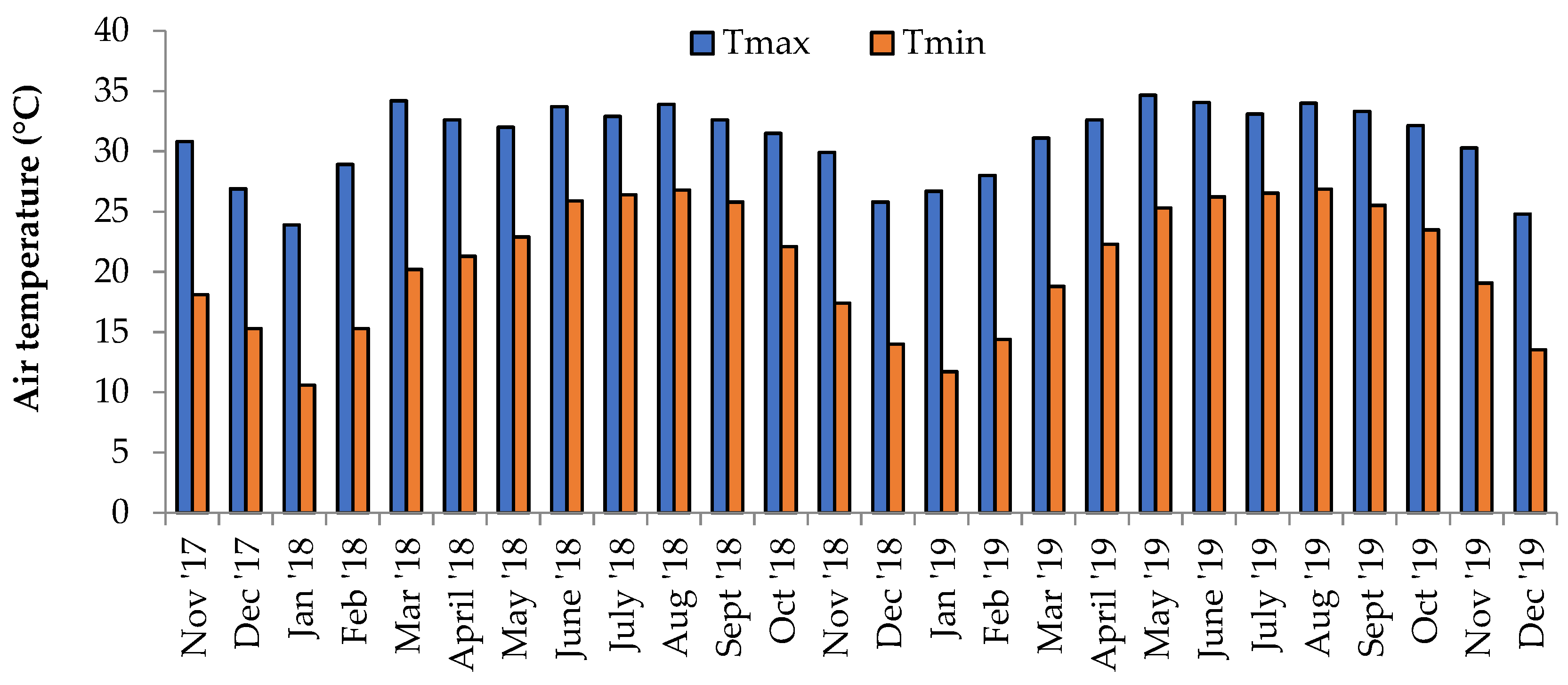
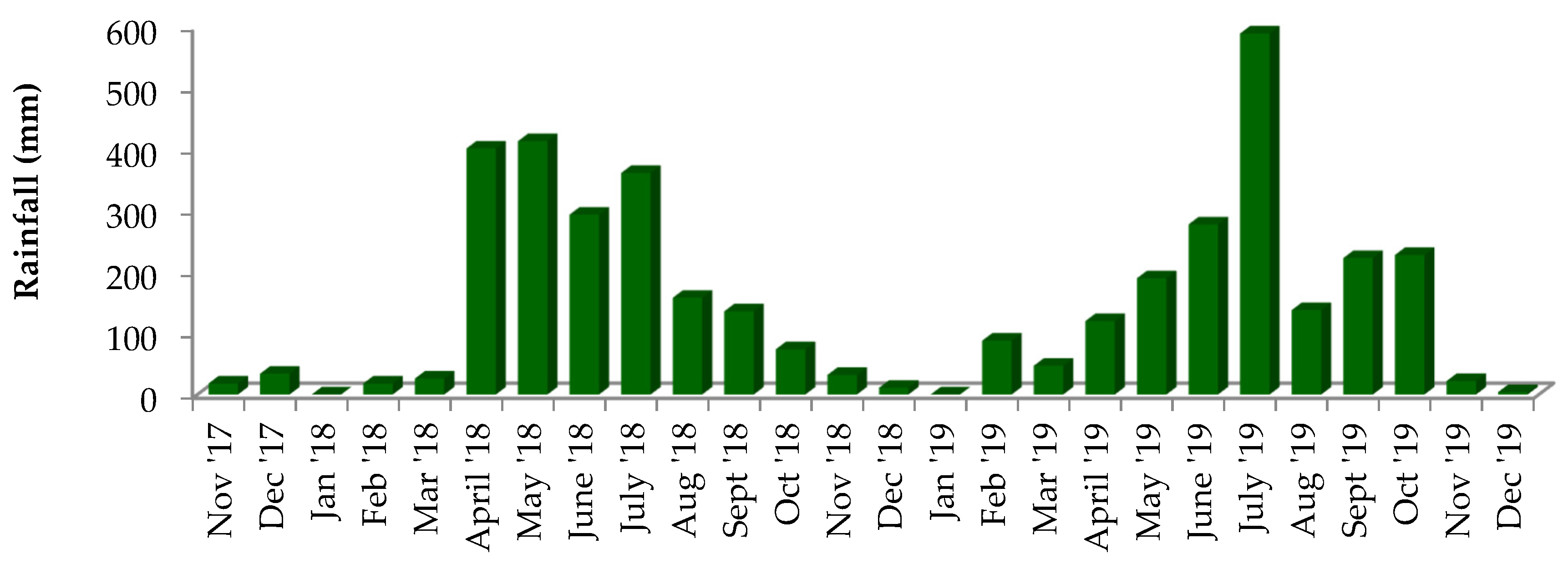
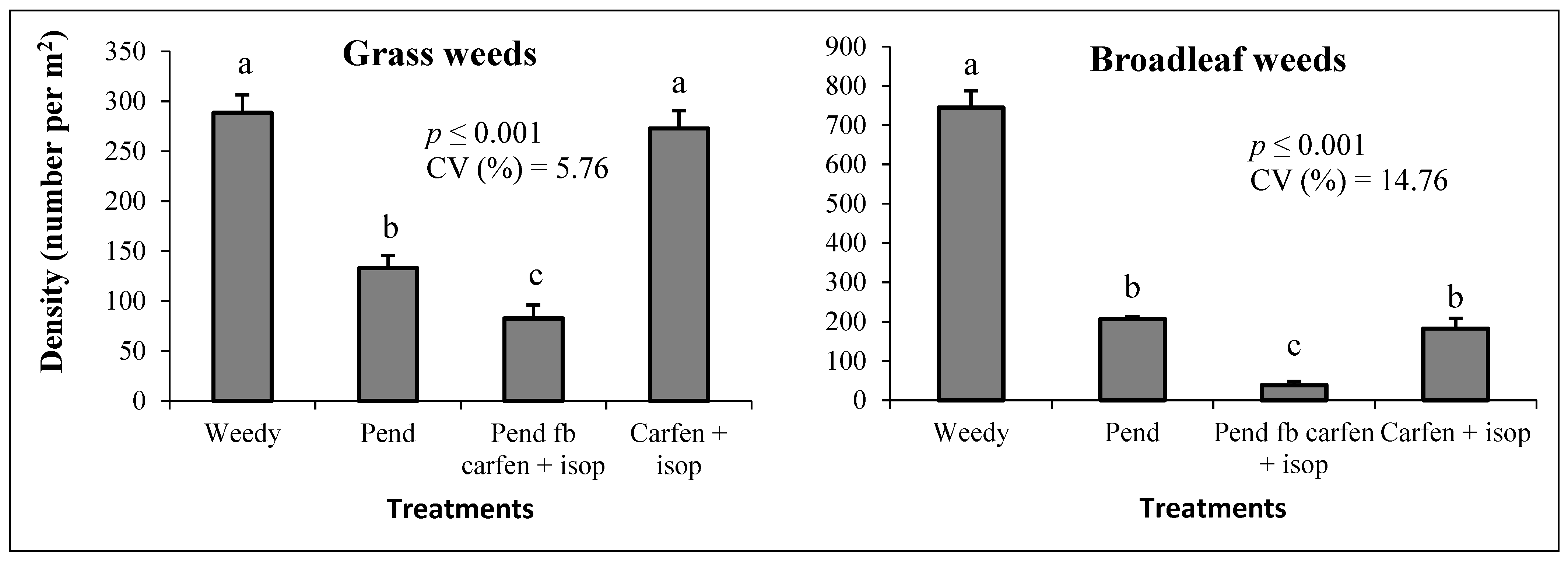
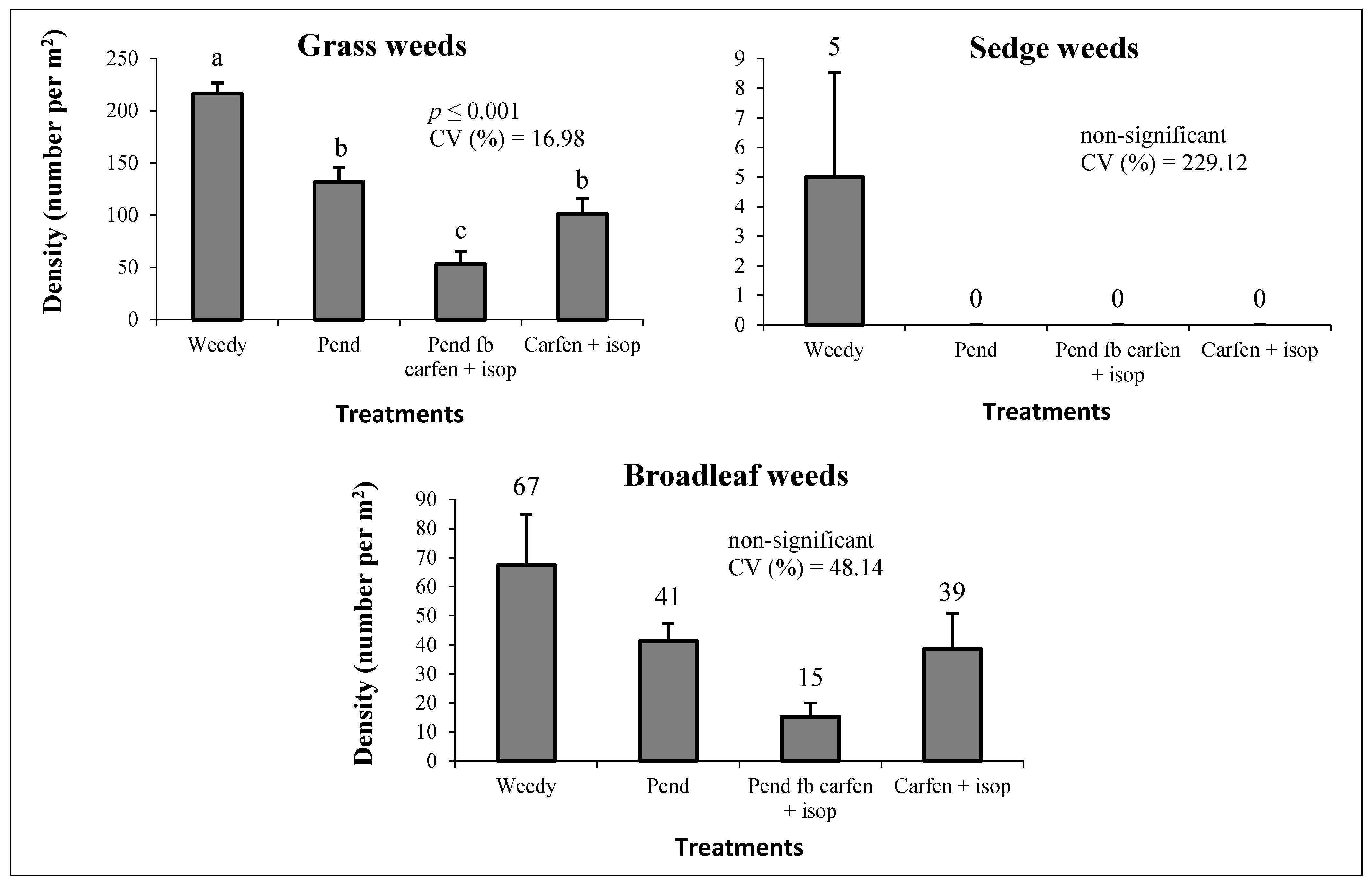
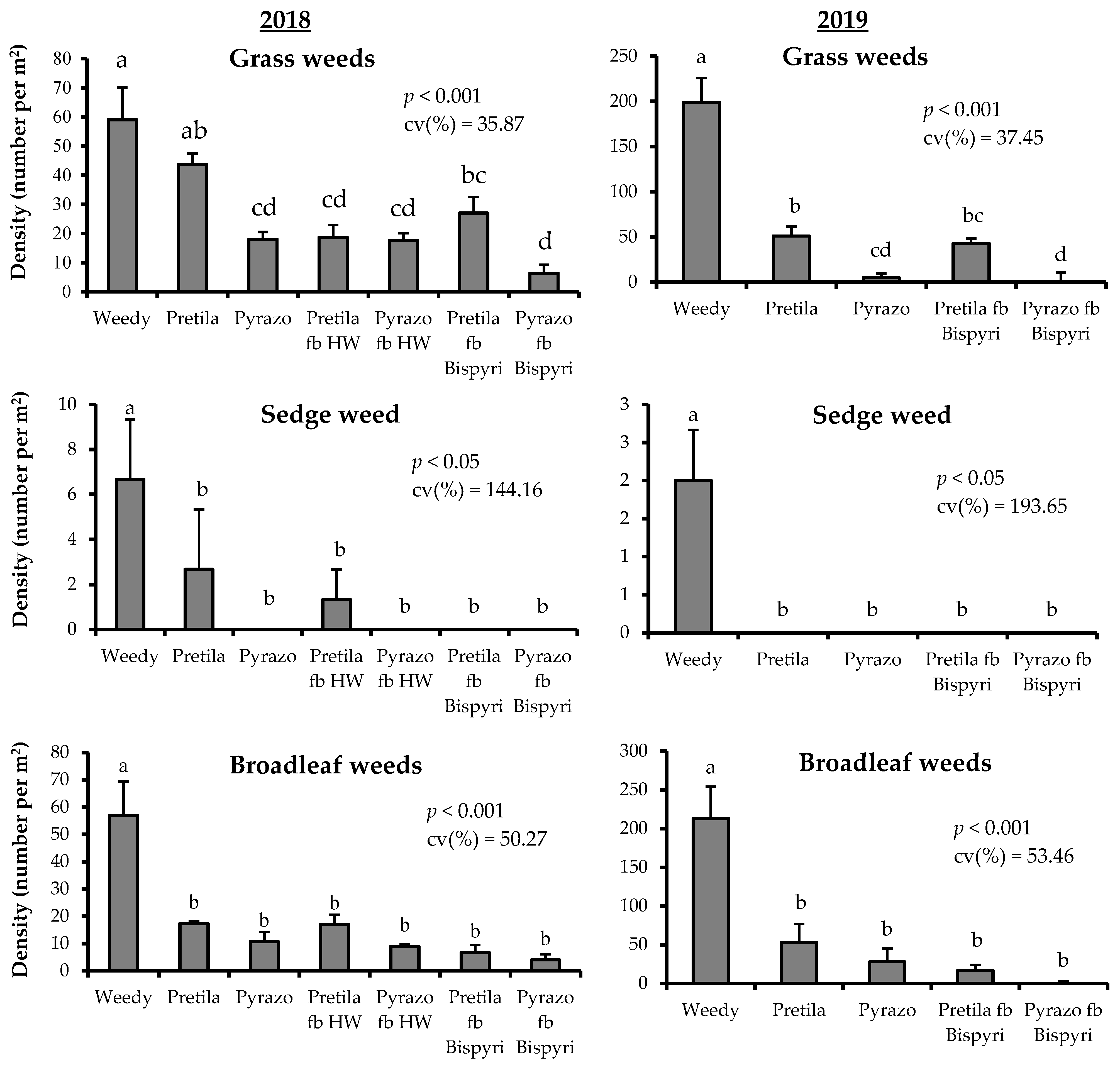
| Properties | pH | OM (%) | Total N (%) | P (µg/g Soil) | K (meq./100 g Soil) | S (µg/g Soil) | Zn (µg/g Soil) | B (µg/g Soil) | Soil Texture |
|---|---|---|---|---|---|---|---|---|---|
| Value | 5.04 | 0.87 | 0.053 | 12.69 | 0.227 | 15.00 | 0.788 | 0.213 | Sandy loam |
| Interpretation | Acidic | Low | VL | M | Opt | M | M | L |
| Crops | Herbicides | Equipment | |||
|---|---|---|---|---|---|
| Chemical Name | Commercial Name | Rate of Application | Manufacturers | ||
| Wheat | Pendimethalin | Panida33EC | 1.0 kg ha−1 | Auto crop care Ltd., Dhaka, Bangladesh | A hand-operated knapsack sprayer (plastic-bodied) with a flat-fan nozzle was used for spraying the herbicide |
| Carfentrazone–ethyl + Isoproturon | Affinity 50.75WP | 25.51 kg ha−1 | Auto crop care Ltd., Dhaka, Bangladesh | ||
| Rainy season rice | Pretilachlor | Commit 500EC | 0.5 kg ha−1 | Auto crop care Ltd., Dhaka, Bangladesh | |
| Pyrazosulfuron–ethyl | Manage 10WP | 1.5 g ha−1 | MacDonald Ltd., Dhaka, Bangladesh | ||
| Bispyribac–sodium | Prune 20WP | 150 g ha−1 | Auto crop care Ltd., Dhaka, Bangladesh | ||
| Crops | Variety | Date of Planting | Date of Harvest |
|---|---|---|---|
| Wheat | BARI Gom 30 | 29 November 2017 17 November 2018 | 20 March 2018 26 March 2019 |
| Mung bean | BARI mung 6 | 28 March 2018 7 April 2019 | Damaged due to heavy rainfall (Figure 2) |
| Rainy season rice | BRRI dhan71 | 08 July 2018 29 July 2019 | 21 October 2018 12 November 2019 |
| Weed Species | English Name | EPPO Code | Family | Life Cycle | % Weed Infestation (Based on Weed Density) | |
|---|---|---|---|---|---|---|
| 2017–2018 | 2018–2019 | |||||
| Grass | ||||||
| Cynodon dactylon | Bermuda grass | CYNDA | Poaceae | Perennial | 16.5 | 12.9 |
| Digitaria sanguinalis | Crab grass | DIGSA | Poaceae | Annual | 3.9 | 30.9 |
| Echinochloa colonum | Jungle rice | ECHCO | Poaceae | Annual | 7.5 | 14.3 |
| Echinochloa crus-galli | Barnyard grass | ECHCG | Poaceae | Annual | - | 11.2 |
| Oryza rufipogon | Wild rice | ORYRU | Poaceae | Annual | - | 5.7 |
| Sedge | ||||||
| Cyperus rotundus | Nutsedge | CYPRO | Cyperaceae | Perennial | - | 1.8 |
| Broadleaf | ||||||
| Polygonum hydropiper | Marsh pepper | POLHY | Polygonaceae | Perennial | 2 | - |
| Vicia sativa | Wild lentil/vetch | VICSA | Fabaceae | Perennial | - | 1.8 |
| Physalis heterophylla | Clammy ground cherry | PHYHE | Solanaceae | Perennial | 63.9 | 0.9 |
| Portulaca oleracea | Common purslane/duckweed | POROL | Portulacaceae | Perennial | 1.3 | - |
| Eclipta prostrata | False daisy | ECLAL | Asteraceae | Perennial | 3.3 | - |
| Chenopodium album | Lamb’s quarters | CHEAL | Amaranthaceae | Perennial | 1.6 | - |
| Pseudognaphalium affine | Cud weed | GNAAF | Asteraceae | Perennial | - | 1.4 |
| Enhydra fluctuans | Water spinach | - | Asteraceae | Perennial | - | 15.0 |
| Amaranthus viridis | Slender amaranth | AMAVI | Amaranthaceae | Perennial | - | 0.9 |
| Alternanthera sessilis | Dwarf copper leaf | ALRSE | Amaranthaceae | Perennial | - | 1.8 |
| Brassica kaber | Wild mustard/charlock | SINAR | Brassicaceae | Perennial | - | 0.9 |
| Lindernia procumbens | Lindernia | LIDPY | Linderniaceae | Annual | - | 0.5 |
| Treatments | Total Weed Density (no. m−2) | Total Dry Biomass (g m−2) | ||
|---|---|---|---|---|
| 2017–2018 | 2018–2019 | 2017–2018 | 2018–2019 | |
| Weedy check | 1033.3 a | 289.0 a | 95.72 a | 76.80 a |
| Pendimethalin | 340.0 c | 173.3 b | 20.07 b | 44.80 b |
| Pendimethalin fb Carfentra + isoproturon | 120.7 d | 68.7 c | 7.77 d | 22.53 b |
| Carfentra + isoproturon | 455.3 b | 140.0 b | 12.59 c | 30.67 b |
| F-Test | *** | *** | *** | ** |
| CV (%) | 8.66 | 17.52 | 7.07 | 27.35 |
| Treatments | Tillers (no. m−2) | Heads (no. m−2) | Spike Length (cm) | Grains Spike−1 (no.) | Grain Yield (t ha−1) | Straw Yield a (t ha−1) |
|---|---|---|---|---|---|---|
| Weedy check | 136 d | 132 d | 16.67 | 31 c | 0.92 d | 1.89 c |
| Weed-free check | 345 b | 342 b | 17.20 | 38 b | 4.00 a | 5.94 ab |
| Pendimethalin | 320 c | 315 c | 16.87 | 40 ab | 3.01 c | 5.55 b |
| Pendimethalin fb Carfen + isop | 416 a | 413 a | 17.27 | 42 a | 4.20 a | 6.36 a |
| Carfen + isop | 343 bc | 339 b | 16.97 | 36 b | 3.62 b | 6.01 ab |
| F-Test | *** | *** | ns | ** | *** | *** |
| CV (%) | 4.25 | 3.75 | 5.96 | 5.15 | 6.09 | 3.33 |
| Treatments | Tillers (no. m−2) | Heads (no. m−2) | Spike Length (cm) | Grains Spike−1 (no.) | Grain Yield (t ha−1) | Straw Yield a (t ha−1) |
|---|---|---|---|---|---|---|
| Weedy check | 251 c | 246 c | 17.0 | 43.9 | 2.29 c | 3.60 c |
| Weed-free check | 343 a | 339 ab | 17.2 | 41.3 | 3.53 b | 4.73 b |
| Pendimethalin | 337 a | 332 ab | 17.4 | 45.1 | 3.27 b | 4.53 b |
| Pendimethalin fb Carfentra + isoproturon | 357 a | 350 a | 17.5 | 46.6 | 4.27 a | 5.20 a |
| Carfentra + isoproturon | 303 b | 299 b | 17.3 | 45.7 | 3.73 ab | 4.70 b |
| F-Test | *** | ** | ns | ns | ** | *** |
| CV (%) | 5.56 | 6.78 | 2.30 | 4.77 | 10.35 | 4.92 |
| Treatments | Cost of Production (USD ha−1) | Gross Return (USD ha−1) | Net Benefit (USD ha−1) | |||
|---|---|---|---|---|---|---|
| 2017–2018 | 2018–2019 | 2017–2018 | 2018–2019 | 2017–2018 | 2018–2019 | |
| Weedy check | 459.2 | 467.5 | 351.1 | 503.6 | −108.1 (−113.0%) | 36.1 (−94.4%) |
| Weed-free check | 667.5 | 675.8 | 1499.3 | 1317.0 | 831.8 | 641.2 |
| Pendimethalin | 493.4 | 501.7 | 1141.1 | 1221.8 | 647.7 (−22.1) | 720.1 (+12.3%) |
| Pendimethalin fb Carfen + isop | 532.0 | 540.4 | 1575.7 | 1586.9 | 1043.7 (+25.5%) | 1046.5 (+63.2%) |
| Carfen + isop | 497.8 | 506.1 | 1364.4 | 1388.1 | 866.6 (+4.2%) | 882.0 (+37.6%) |
| Weed Species | English Name | EPPO Code | Family | Life Cycle | % Weed Infestation (Based on Weed Density) | ||
|---|---|---|---|---|---|---|---|
| 2018 | 2019 | ||||||
| Grass | |||||||
| Cynodon dactylon | Bermuda grass | CYNDA | Poaceae | Perennial | 7.6 | 15.7 | |
| Leptochloa chinensis | Asian sprangletop | LEFCH | Poaceae | Annual/Perennial | 19.8 | 8.9 | |
| Echinochloa colonum | Jungle rice | ECHCO | Poaceae | Annual | 13.0 | 1.6 | |
| Leersia hexandra | Swamp rice grass | LERHE | Poaceae | Annual/Perennial | 5.4 | 15.1 | |
| Paspalum commersonii | Paspalum grass | PASSC | Poaceae | Annual | 2.3 | - | |
| Sporobolus tremulus | Seed thrower grass | SPZTR | Poaceae | Annual | - | 6.4 | |
| Sedge | |||||||
| Fimbristylis miliacea | Grasslike fimbry | FIMMI | Cyperaceae | Annual/Perennial | 5.4 | 0.3 | |
| Broadleaf | |||||||
| Ludwigia decurrens | Willow primrose | IUSDE | Onagraceae | Annual | 15.2 | 1.9 | |
| Jussiaea repens | Water primrose | LUDAC | Onagraceae | Perennial | 7.6 | 2.2 | |
| Monochoria vaginalis | Pickerelweed | MOOVA | Pontederiaceae | Annual/Perennial | 1.1 | - | |
| Enhydra fluctuans | Water spinach | - | Asteraceae | Perennial | 8.4 | 6.4 | |
| Alternanthera sessilis | Dwarf copperleaf | ALRSE | Amaranthaceae | Perennial | 14.2 | 40.1 | |
| Commelina benghalensis | Tropical spiderwort | COMBE | Commelinaceae | Annual | - | 0.9 | |
| Lindernia procumbens | Lindernia grass | LIDPY | Scrophulariaceae | Annual | - | 0.4 | |
| Treatments | Total Weed Density (no. m−2) | Total Weed Dry Biomass (g m−2) | ||
|---|---|---|---|---|
| 2018 | 2019 | 2018 | 2019 | |
| Weedy check | 122.7 a | 416.0 a | 83.85 a | 78.09 a |
| Pretilachlor | 63.7 b | 104.3 b | 37.13 b | 25.13 b |
| Pyrazosulfuron–ethyl | 28.7 bc | 33.3 cd | 22.28 c | 9.94 cd |
| Pretilachlor fb bispyribac | 33.7 bc | 60.0 bc | 13.81 c | 16.22 bc |
| Pyrazosulfuron–ethyl fb bispyribac | 10.3 c | 0.0 d | 10.85 c | 0.00 d |
| F-Test | *** | *** | *** | *** |
| CV (%) | 37.66 | 34.51 | 20.24 | 19.27 |
| Treatments | Tillers (no. m−2) | Effective Tillers (no. m−2) | Filled Grains Panicle−1 (No.) | Grain Yield (t ha−1) | ||||
|---|---|---|---|---|---|---|---|---|
| 2018 | 2019 | 2018 | 2019 | 2018 | 2019 | 2018 | 2019 | |
| Weedy check | 271 d | 293 c | 261 c | 241 d | 120 c | 159 b | 4.88 e (−36.0%) | 4.22 d (−40.1%) |
| Weed-free check | 304 ab | 335 ab | 302 ab | 312 ab | 141 b | 170 ab | 7.62 b | 7.04 a |
| Preti | 283 cd | 305 bc | 280 bc | 274 c | 139 b | 160 b | 6.09 d (−20.1%) | 5.21 c (−26.0%) |
| Pyrazo | 291 bc | 344 a | 287 ab | 304 abc | 149 ab | 177 ab | 6.72 c (−11.8%) | 6.08 b (−13.6%) |
| Preti fb bispyr | 306 ab | 316 bc | 301 ab | 282 bc | 149 ab | 170 ab | 7.56 b (−0.8%) | 5.74 b (−18.5%) |
| Pyrazo fb bispyr | 310 a | 351 a | 307 a | 332 a | 156 a | 182 a | 8.36 a (+9.7%) | 7.36 a (+4.5%) |
| F-Test | ** | ** | ** | *** | *** | ** | *** | *** |
| CV (%) | 3.25 | 3.79 | 4.19 | 4.29 | 4.40 | 6.88 | 3.17 | 3.91 |
| Treatments | Cost of Production (USD ha−1) | Gross Return (USD ha−1) | Net Benefit (USD ha−1) | |||
|---|---|---|---|---|---|---|
| 2018 | 2019 | 2018 | 2019 | 2018 | 2019 | |
| Weedy check | 557.5 | 558.1 | 1346.9 | 1193.9 | 789.4 (−36.0%) | 635.8 (−40.2) |
| Weed-free check | 870.0 | 870.6 | 2104.3 | 1934.2 | 1234.3 | 1063.6 |
| Preti | 571.1 | 571.7 | 1715.7 | 1480.4 | 1144.6 (−7.3%) | 908.8 (−14.6) |
| Pyrazo | 566.3 | 566.9 | 1872.4 | 1710.9 | 1306.1 (+5.8%) | 1144.0 (+7.6%) |
| Preti fb bispyri | 582.4 | 583.0 | 2094.1 | 1649.9 | 1511.7 (+22.5) | 1067.0 (+0.3%) |
| Pyrazo fb bispyri | 577.6 | 578.2 | 2283.4 | 2026.5 | 1705.8 (+38.2) | 1448.3 (+36.2%) |
Publisher’s Note: MDPI stays neutral with regard to jurisdictional claims in published maps and institutional affiliations. |
© 2021 by the authors. Licensee MDPI, Basel, Switzerland. This article is an open access article distributed under the terms and conditions of the Creative Commons Attribution (CC BY) license (https://creativecommons.org/licenses/by/4.0/).
Share and Cite
Zahan, T.; Hossain, M.F.; Chowdhury, A.K.; Ali, M.O.; Ali, M.A.; Dessoky, E.S.; Hassan, M.M.; Maitra, S.; Hossain, A. Herbicide in Weed Management of Wheat (Triticum aestivum L.) and Rainy Season Rice (Oryza sativa L.) under Conservation Agricultural System. Agronomy 2021, 11, 1704. https://doi.org/10.3390/agronomy11091704
Zahan T, Hossain MF, Chowdhury AK, Ali MO, Ali MA, Dessoky ES, Hassan MM, Maitra S, Hossain A. Herbicide in Weed Management of Wheat (Triticum aestivum L.) and Rainy Season Rice (Oryza sativa L.) under Conservation Agricultural System. Agronomy. 2021; 11(9):1704. https://doi.org/10.3390/agronomy11091704
Chicago/Turabian StyleZahan, Taslima, Md Faruque Hossain, Apurba K. Chowdhury, Md Omar Ali, Md Akkas Ali, Eldessoky S. Dessoky, Mohamed M. Hassan, Sagar Maitra, and Akbar Hossain. 2021. "Herbicide in Weed Management of Wheat (Triticum aestivum L.) and Rainy Season Rice (Oryza sativa L.) under Conservation Agricultural System" Agronomy 11, no. 9: 1704. https://doi.org/10.3390/agronomy11091704
APA StyleZahan, T., Hossain, M. F., Chowdhury, A. K., Ali, M. O., Ali, M. A., Dessoky, E. S., Hassan, M. M., Maitra, S., & Hossain, A. (2021). Herbicide in Weed Management of Wheat (Triticum aestivum L.) and Rainy Season Rice (Oryza sativa L.) under Conservation Agricultural System. Agronomy, 11(9), 1704. https://doi.org/10.3390/agronomy11091704











